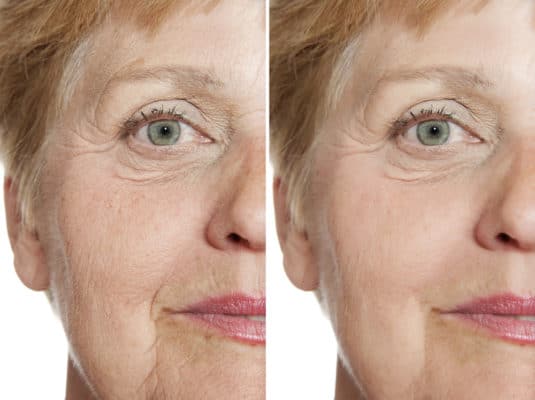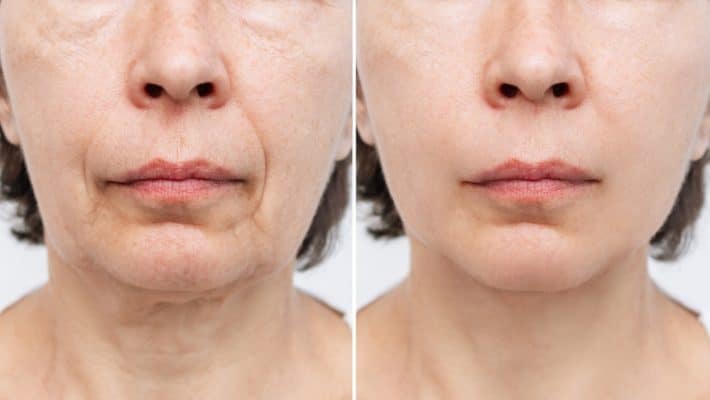RHA Fillers in Scottsdale, AZ
Dermal fillers have made breakthroughs in eliminating fine lines and wrinkles while still offering natural-looking, expressive results. In the past, fillers targeted only static lines in the face. RHA fillers provide a new solution to restoring your face’s youthful volume.
Dr. Todd Shatkin and the expert team at Scottsdale Dental and Facial Aesthetics offer the latest advancements in helping you to look and feel your best. We want our patients to have the best options in non-surgical anti-aging treatments, so we invest in the newest treatments to rejuvenate your skin.
Resilient hyaluronic acid fillers are the next big thing in treating dynamic wrinkles, and Scottsdale Dental and Facial Aesthetics wants you to know all about them.
What Are Dynamic and Static Wrinkles?
 When faces express emotions, dynamic wrinkles appear. They’re the lines that show in the face when you furrow your brow, lift your eyebrows with surprise, or crinkle your eyes in laughter. Dynamic wrinkles appear while you’re making a facial expression and disappear when you’re no longer making that expression.
When faces express emotions, dynamic wrinkles appear. They’re the lines that show in the face when you furrow your brow, lift your eyebrows with surprise, or crinkle your eyes in laughter. Dynamic wrinkles appear while you’re making a facial expression and disappear when you’re no longer making that expression.
Over time and through the loss of collagen and elastin, dynamic wrinkles begin to form static wrinkles, which remain on the face regardless of your emotion.
In the past, neuromodulators like Dysport were the only option for treating dynamic wrinkles, while dermal fillers like Juvéderm and Restylane were the only options for static wrinkles.
Neuromodulators disrupt nerve signals to the muscles, stopping their movement and thus, stopping dynamic wrinkles from forming and worsening. The Plastic Surgery Statistics Report saw over 4 million neuromodulator treatments for dynamic wrinkles in 2020. Now, those patients have another option in RHA fillers.

What Are RHA Fillers?
Resilient hyaluronic acid (RHA) fillers are the first FDA-approved anti-aging solution of their kind. Uniquely formulated to restore facial volume and smooth lines, RHA fillers also adapt to facial movements, so patients no longer experience an unnatural, frozen look familiar with other treatments.
Like other hyaluronic acid-based fillers, RHA fillers have different formulations to better treat specific areas of the face. In addition, these formulations offer different stretch and strength and include:
RHA 2
RHA 2 filler treats surface lines and wrinkles, including vertical lip lines, the radial lines that fan out from your mouth when smiling, glabellar lines between the eyebrows, and crow’s feet. RHA 2 injections target the mid-to-deep dermis layers and are approved for use in adults aged 22 and older.
RHA 3
RHA 3 filler targets deep wrinkles, such as those in the nasolabial folds, which run between the nose and the mouth, and those found at the corners of the mouth. Many patients also use RHA 3 to add volume to the lips and cheeks.
Like RHA 2, these injections target the mid-to-deep layers of the dermis and are for use in adults 22 and older.
RHA 4
RHA 4 fillers target the deepest creases in the face, such as more severe nasolabial folds, jowls, marionette lines, and volume and definition loss in the cheeks. Of the three types of RHA fillers, RHA 4 offers the most potency and least stretch, offering more structure to the skin.
RHA 4 injections go deeper into the skin’s layers, targeting the subcutaneous tissue in adults 22 and older.

How Are RHA Fillers Different from Hyaluronic Acid Fillers?
Hyaluronic acid-based fillers are a popular option in treating volume loss, fine lines, and wrinkles. Hyaluronic acid (HA) is a sugar naturally in the skin, attracting and retaining water to offer a plump, youthful glow.
RHA fillers also use hyaluronic acid, but these fillers use some of the longest chains of hyaluronic acid on the market. Why does that matter? Because RHA chains match the natural hyaluronic acid chains in the body. They also contain fewer chemical modifications and are processed at a lower temperature.
These differences in the formulation of RHA fillers and HA fillers allow RHA fillers to closely match the body’s natural hyaluronic acid. Hence, they maintain more natural structure and stretch, making them more resilient.
RHA fillers are beneficial for patients looking for the youthful-looking skin offered through the filler but with more organic results. Patients get the long-lasting, volume-restoring benefits of HA fillers with a more natural look that better mimics the body’s hyaluronic acid.
What Areas Can I Treat with RHA Fillers?
RHA fillers work specifically to restore volume to the face, which depletes over time. They can reduce lines, fill and contour your face’s shape, and bring back skin’s youthful appearance. RHA fillers work best on areas that develop dynamic facial wrinkles and folds, including:
- Chin lines
- Lines around the mouth
- Nasolabial folds
- Marionette lines
- Lips
- Cheeks
- Jowls
Patients prefer RHA fillers because they adapt to facial movements, providing a naturally younger look in more mobile areas of the face, including the eyes, cheeks, and mouth.
What Can I Expect from RHA Filler Treatments?
Before your RHA filler treatments, you’ll first have a complimentary consultation with Dr. Shatkin at Scottsdale Dental and Facial Aesthetics. During this appointment, you can discuss your aesthetic goals, previous treatments, and concerns.
Patients don’t need to undergo any special preparations before RHA filler treatments. However, those with more sensitive skin may discuss strategies with Dr. Shatkin to minimize any common side effects of dermal injections.
Before your initial treatment, Dr. Shatkin will map your face to target areas where RHA injections will provide the most benefit to your overall appearance.
RHA filler treatments usually take 15-25 minutes, depending on the treatment areas. Most patients report feeling only a pinch from the injections themselves, as RHA fillers already contain lidocaine, making the treatments well-tolerated.
Immediately after your injections, Dr. Shatkin may massage the treatment areas to disperse the gel more evenly.
Like HA fillers, RHA fillers can be dissolved. Patients can also undergo touch-ups from their RHA treatments two to four weeks after the initial injections.
RHA Filler Recovery and Results
After your RHA filler treatments, you’ll be able to resume your everyday activities. However, we advise avoiding any strenuous activities for at least one day.
Initial results from RHA filler treatments are immediate since RHA fillers begin to work as soon as they’re injected into the skin. Your results will continue to improve for the next 24-48 hours.
Since RHA treatments resemble your body’s natural hyaluronic acid so closely, treatments take longer to break down and become absorbed by the body. Most patients enjoy their results for approximately 15 months before they need further treatments to maintain their smooth, younger-looking skin.
Am I a Candidate for RHA Fillers?
Anyone looking to add volume, smooth lines, and shape the contours of their face may be a candidate for RHA fillers. Resilient hyaluronic acid is safe for all skin types and tones and closely resembles the sugars already present in the skin, making them well-tolerated.
Achieve Youthful-Looking Skin at Scottsdale Dental and Facial Aesthetics
Even minimally-invasive cosmetic treatments require the hands of a skilled professional to offer optimal results. At Scottsdale Dental and Facial Aesthetics, Dr. Shatkin brings 30 years of experience to his procedures, offering patients the expertise to bring forth their natural beauty.
When you’re ready to smooth, lift, and contour your skin without undergoing invasive surgery, trust the Scottsdale Dental and Facial Aesthetics team and schedule your complimentary consultation today!
